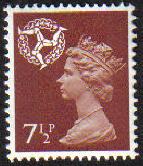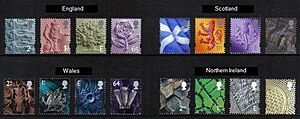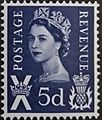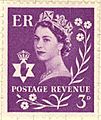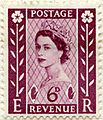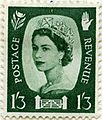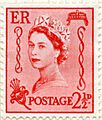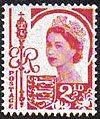Country definitives facts for kids
Country definitives, also known as regional postage stamps of Great Britain, are special postage stamps. They are made for different parts of the United Kingdom and its islands. These stamps show the unique identity of each area.
Great Britain first issued postage stamps in May 1840. These stamps could be used across the whole United Kingdom of Great Britain and Ireland. After 1922, they were valid in the United Kingdom of Great Britain and Northern Ireland.
In 1958, special regional stamps were introduced. The Channel Islands, Isle of Man, Northern Ireland, Scotland, and Wales got their own stamps. The designs used the same picture of the Queen as the Wilding stamps. But they also included symbols for each of these home nations and Crown dependencies.
Later, the regional stamps for Northern Ireland, Scotland, Wales, and the Isle of Man changed. This happened when the UK switched to decimal money. These new stamps were part of the Machin designs. They had the relevant symbols in the top left corner. Between 1999 and 2000, new designs were created for the four home nations.
These stamps were usually sold in post offices in their own areas. However, they could be used anywhere in the UK. They were also valid in the Crown Dependencies until those places started issuing their own stamps.
Contents
Why Regional Stamps?
The idea for regional stamps came up after World War II. It was first suggested to help tourism in the Channel Islands. These islands had been taken over by German forces during the war. The idea then grew to include all regions of the United Kingdom. Designs were made showing King George VI's head and regional symbols.
The First Regional Stamps (1958)
Special groups were formed to pick the symbols for each country or island. The first regional stamp (a 3d deep lilac stamp) came out on August 18, 1958. It was released in the Channel Islands, Isle of Man, Scotland, Wales, and Northern Ireland. The design featured Dorothy Wilding's picture of the Queen. It was surrounded by symbols important to that region. Other stamp values were released later.
The colors of these stamps were the same across all regions. Only the 4d stamp changed color. It was first ultramarine, then olive-sepia, and finally vermilion. The 4d stamp's color changed to match the new Machin series. It changed again because people complained that postmark dates were hard to read on the dark color. So, all regional 4d stamps were changed to the new vermilion color.
Scotland's Stamps
The Scottish group chose designs by John B. Fleming, Gordon F. Huntly, and Archie B. Imrie.
Wales' Stamps
The Welsh group chose the Welsh Dragon and the leek as symbols. Three designs by Reynolds Stone were picked.
Northern Ireland's Stamps
Creating stamps for Northern Ireland was a bit tricky. It was hard to find symbols that would represent the area without causing political arguments. The committee decided to use Dorothy Wilding's portrait of the Queen with other symbols. These included the Red Hand of Ulster, the Arms of Northern Ireland, and the Flax Plant. Several local artists created designs. The Queen chose one from each artist. Designs by Thomas Collins, Leonard Pilton, and William Hollywood were chosen for release.
Channel Islands' Stamps
Eric Piprell designed the Guernsey stamps. These stamps showed the Crown of William the Conqueror and the Guernsey lily. He also designed a 2+1⁄2d stamp with a similar lily and crown theme.
William Gardner designed the Jersey stamps. His design featured the Mace given to the island by Charles II in 1663. It also showed the Arms of Jersey. Small potato and tomato plants were in the borders. This showed how important farming was. The 2+1⁄2d Jersey stamp was designed by Edmund Blampied. It also used the Mace and Arms but in different positions.
Jersey and Guernsey started issuing their own stamps on October 1, 1969. This meant they became postally independent.
The Isle of Man's Stamps
John Nicholson designed the Isle of Man stamps. They included the tre cassyn (Three Legs) symbol on a shield. The design also had a ring-chain pattern around the edge. This pattern was based on old Manx stone crosses.
Decimal Stamps
On July 7, 1971, the older Wilding designs for the Isle of Man, Scotland, Wales, and Northern Ireland were replaced. New designs similar to the standard British Machin stamps were used. Each stamp had a smaller picture of Queen Elizabeth II by Arnold Machin. A national symbol was placed in the top left corner. These symbols were designed by Jeffery Matthews.
The symbols used were:
- Isle of Man: The triskelion (three legs).
- Northern Ireland: The "Red Hand" in a star under a crown.
- Scotland: The lion rampant (a standing lion).
- Wales: The Welsh dragon.
The colors of these Machin regional stamps were mostly the same as the main Machin stamps. However, some were slightly different, like the 4½p regionals, which were a darker blue. Many different values of these stamps were released. This is because they were used in these regions for the rest of the 20th century.
The Isle of Man became able to issue its own stamps on July 5, 1973. Because of this, only four Machin values were ever released for this region:
- 2+1⁄2p bright magenta
- 3p ultramarine
- 5p reddish violet
- 7+1⁄2p chestnut
Pictorial Stamps
In the late 1990s, new designs were made for each of the four British home nations. For the first time, this included England. Four different values were issued for each nation. Scotland and Wales got theirs on June 8, 1999. Northern Ireland followed on March 6, 2001. Finally, England's stamps came out on April 23, 2001. Each stamp showed symbols important to its country.
These stamps first had no borders. But in 2003, they were replaced with stamps that had white borders. As postal rates changed, the values on some stamps also changed. The '2nd' and '1st' values stayed the same. However, the 'E' value changed from 40p to 42p, then 44p, 48p, 50p, and 56p. Other values like 64p and 65p were reissued as 68p, 72p, 78p, 81p, 90p, and 97p. By 2020, values were £1.42 and £1.63. In 2021, the 'third' stamp increased to £1.70, then to £1.80 in 2022.
Images for kids


